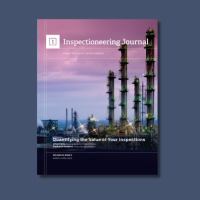If you cannot quantify the uncertainty of when your assets will fail, you will never recognize the full value of your risk analysis. In this video, Ryan Sitton, Pinnacle’s Founder, and CEO, walks through the impact of leveraging data to quantify uncertainty, decrease downtime, and better define whether an upcoming task should be a repair, replacement, or upgrade.
The Concept of Uncertainty/Combating Uncertainty
The concept of quantifying uncertainty is a novel approach for many industrial facilities. However, despite advancements in technology and risk analysis methodologies, there’s still uncertainty associated with how long an asset will operate before failing. One way to minimize this uncertainty is through monitoring. While taking thickness measurements, evaluating flow rates, and analyzing the contents of the fluids can help facilities identify the specific failure modes of an asset and reduce uncertainty, ultimately, the value of monitoring is limited.
The uncertainty of a specific asset impacts more than the life of the asset in question; it impacts the uncertainty of the entire system of assets connected to it. Many facilities have historically managed this data type in siloes, making it difficult to use in future analyses. As an industry, there’s an opportunity to better connect the impact of an asset’s data on the overall system so that facilities can plan tasks that will reduce spending, decrease downtime, and minimize risk more proactively.
So how do we apply the concept of uncertainty to an asset? Using the example mentioned in the above video, if we’re studying a specific piece of pipe, we need to understand what’s happening with it and the range of uncertainty associated with its failure. As we begin to narrow the degree of uncertainty by learning more about this pipe and its surrounding assets, we can better plan for the proactive activities that need to be incorporated into the plan.
How Can You Minimize Uncertainty?
One way to minimize uncertainty is through Lifetime Variability Curves (LVC). An LVC is a data-driven model that leverages a facility’s data to estimate asset performance, predict failure, and quantify uncertainty. LVC works similarly to a hurricane tracker. As the model collects more data in real-time, it becomes more refined and predicts when assets will fail. This model helps facilities pinpoint the impact of individual data points on a system of assets to identify the activities that need to be completed to reduce risk.

Quantifying the Value of Your Inspections
Learn how two refineries quantified the uncertainty associated with different inspection techniques to confidently identify which inspections could be postponed, removed, or added to improve production.
Read more >

Reduce Your Uncertainty with Quantitative Reliability Optimization (QRO)
Quantitative Reliability Optimization (QRO) is a methodology that measures the uncertainty of your reliability data. Learn how this approach can help you identify the tasks that actually impact your facility’s performance.
Read more >

Supermajor Uses QRO to Predict 94.22% Availability and Associated HSE Risk
Learn how a facility modeled severe vibration and thinning scenarios to monitor and understand the impact of real-time data on the facility’s availability, risk, and cost.
Read more >
Stay in the know.
Providing data-driven insights, perspectives, and industrial inspiration from the forefront of the reliability transformation.